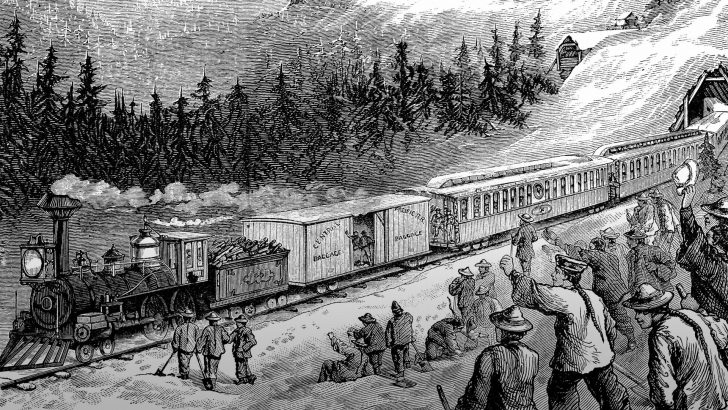Picture this: a vast and untamed land, filled with bison and indigenous communities, stretching from the Atlantic to the Pacific. Now imagine bridging that immense expanse, not by plane or car, but by train. This monumental feat was the Transcontinental Railroad: A vast network of steel, sweat, and ingenuity that, in essence, stitched a burgeoning nation together.
At a staggering 1,912 miles, this grand railway project was more than just tracks and trains; it was the dream of a nation. Built between 1863 and 1869, it connected the existing eastern U.S. rail network at Omaha, Nebraska, with the Pacific coast at the Oakland Long Wharf on San Francisco Bay. But why does this matter so much?
Now, let's embark on a journey through the past to unravel the enduring legacy of the Transcontinental Railroad.

USA News / Back in the 19th century, building the railroad was a challenge in and of itself.
An Economic Powerhouse
One of the most immediate and glaring impacts was economic. Before the railroad, traveling coast to coast took months, whether by wagon or by ship around Cape Horn. Post-railroad? A mere week! This slashed travel time and pumped life into commerce, trade, and the exchange of ideas. Towns like Laramie, Wyoming, and Reno, Nevada, sprang up almost overnight as the railway progressed.
Agriculture, mining, and cattle raising became immensely profitable. The Transcontinental Railroad was essentially the internet of its day, connecting markets and spurring trade like never before.
America on the Move With the Transcontinental Railroad
The allure of the West was undeniable. Gold, silver, and the promise of vast lands had people's heads spinning with dreams of prosperity. With the railroad's completion, moving westward was no longer a perilous journey but a feasible relocation. Between 1870 and 1900, the American West's population swelled from 1% of the nation to a whopping 30%.

Hola / Thanks to the boom of these 'railroad towns', industries throughout the U.S. flourished.
A Melting Pot of Cultures
The construction of the Transcontinental Railroad is also a tale of diversity. Did you know that Central Pacific, which built the western part of the railroad, employed over 10,000 Chinese laborers? That is more than 90% of their workforce!
These workers faced daunting conditions, laying tracks through the treacherous Sierra Nevada Mountains, often at the cost of their lives. The railroad stands as a testament to their endurance. And to the many Irish, German, and African American workers who also toiled under extreme conditions. This fusion of cultures played a significant role in shaping the multicultural tapestry of modern America.
A Shift in Time Before
The railroad, local time was precisely that: Local. Towns set their clocks based on the sun's position, which was a logistical nightmare for scheduling trains. The solution? Time zones! Yes, that is right. The system of Pacific, Mountain, Central, and Eastern time zones was instituted by the railroad companies in 1883, a clear example of how deep the railroad's impacts ran.

US Sun / The Transcontinental Railroad enabled the U.S. to hug foreign workers from all over the world.
The Environmental and Indigenous Impact
However, progress often casts a shadow. Bison, vital to the Great Plains indigenous tribes, were nearly hunted to extinction as the railroad made hunting accessible and their hides profitable.
Furthermore, native communities faced displacement, and their ancestral lands were crisscrossed and claimed by settlers and businesses. It is essential to understand this facet of the railroad's legacy, acknowledging the cost of such monumental progress.





